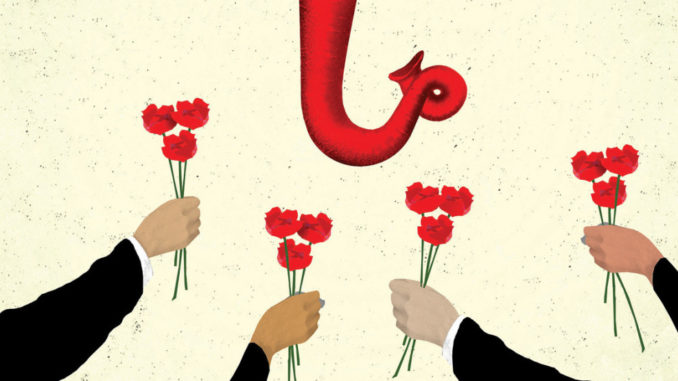
by Yuval Levin
For many conservatives, the 2016 election has been a surreal nightmare. This was a year when a Republican with a powerful conservative message should have been able to ride the public’s frustrations with the Obama years to the White House. And then came Donald Trump, a bombastic real-estate developer and TV star with no discernibly conservative agenda. Not only did many Republican voters cheer him on, but GOP elected officials fell in behind him.
To put it mildly, this election cycle has revealed serious fault lines and weaknesses on the right, and the Republican Party will be working to make sense of it all for years. But for conservatives—I mean those who champion some version of the difficult balance of traditionalism in the moral arena, market mechanisms for addressing our economic challenges and American strength in a dangerous world, all bound by a limited-government constitutionalism—this sorry year’s lessons have one overarching implication: We can no longer treat the GOP simply as our own.
Over the past three decades, conservatives increasingly fell into the habit of taking the party for granted as a vehicle for advancing our views, and taking the Republican electorate for granted as steadfastly conservative. This understanding of the party drove the evolution of a series of policy litmus tests for candidates—commitments on taxes, health care, welfare, education—that were supposedly required to win the allegiance of the GOP’s activists and voters.
But this “conservatism” for politicians became not a worldview but an agenda almost frozen in amber, locking in place a 1980s-style policy program even as the nation changed around us. Rather than applying timeless principles to new problems, we held fast to the increasingly anachronistic policies to which the party was already committed. Heterodox new proposals, including those to the right of the old agenda, couldn’t thrive. And voter dissatisfaction was taken to be merely a function of politicians’ inadequate loyalty to the familiar policy litany.
Then Trump blew it all up. En route to the nomination, he paid nearly no heed to the usual litmus tests; he seemed to have no idea they existed. Instead, he spoke in terms of broadly shared contemporary concerns—from the pressures of the global economy to threats to national identity to a sense that America had lost its edge. It’s not that he had a rival policy prescription; his campaign largely amounts to a frantic venting of frustrations punctuated by demagogic chest-thumping. But his approach clearly appealed to a significant portion of Republican voters.
The response from Trump’s opponents in the primaries was largely a resort to the familiar purity pageant. Texas Senator Ted Cruz, Trump’s strongest challenger, seemed to believe that by proving Trump was no conservative (which was easy enough) he would prove that Republicans shouldn’t vote for him. But “not a conservative” didn’t seem to be much of an insult to large swaths of Republican voters. And Trump eventually made the point explicit: “This is called the Republican Party. It’s not called the Conservative Party,” he said in May.
He had a point. Conservatives are surely still the party’s most significant bloc, but we are not its owners. And to bring the party along we must convince other Republicans who are not first and foremost conservatives. In fact, Trump has reminded us of an important point: Conservatives, like progressives, are a distinct minority in American society, and can succeed only by winning over others who are not already like-minded. By imagining there was a majority coalition for orthodox conservative ideas when there wasn’t even one within the GOP, we neglected the hard work of reconsidering how our ideas might best apply to contemporary challenges. As a result, the right (like the left) simply hasn’t confronted some key 21st-century realities—perhaps, above all, the fragmentation and fracturing of America’s mid-20th-century institutions.
Instead, both progressives and conservatives have tended to look backward to what they take to be America’s 20th-century heyday; it’s just they’re stuck on different years. One party pines for 1965, with its strong post-World War II emphasis on regulated economic corporatism and liberalizing culture. The other is trapped in nostalgia for 1981 and the Reagan revolution of American self-confidence and liberalizing economy. But the truth is, neither can be recaptured.
This myopia is especially harmful for conservatives, who might otherwise offer the country an appealing and effective 21st-century agenda. Think about how accustomed Americans have grown in recent years to the kind of problem-solving that offers endless options and works from the bottom up, rather than imposing centralized bureaucratic control from the top down. We could apply precisely that way of thinking to our lumbering, sclerotic public programs. A fresh agenda of decentralization and federalism could help address some key downsides of our social, economic and cultural fragmentation, drawing us back to the mediating institutions of civil society, which offer an alternative to both radical individualism and stultifying central control.
We’re not there, though. Trump has been a painful shock for many conservatives. But at the least, he might offer an opportunity to rethink our relationship with the party we’ve long considered our own.
Yuval Levin is Hertog Fellow at the Ethics and Public Policy Center, editor of National Affairs and author of The Fractured Republic: Renewing America’s Social Contract in the Age of Individualism.
